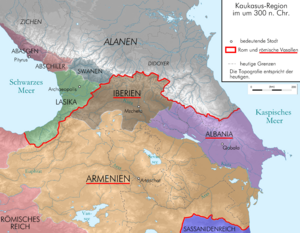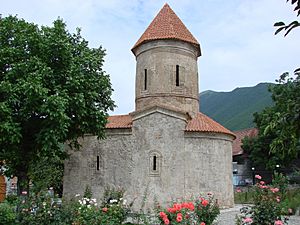Roman influence in Caucasian Albania facts for kids

Caucasian Albania was an ancient land in what is now Azerbaijan. For about 400 years, around the time of Jesus, it was a "client state" of the Roman Empire. This means it was an independent country but was strongly influenced and protected by Rome. Its connection with Rome began in the first century before Christ and lasted until about 250 AD. Later, around 299 AD, Albania was briefly a "vassal state" (meaning it owed loyalty and help) to the Roman emperor Diocletian.
Rome never fully made Caucasian Albania a "province" (a direct part of its empire), unlike its neighbor, Roman Armenia. However, Rome brought Christianity to the people of Caucasian Albania. This led to a Western cultural influence that can still be seen in Azerbaijan today. Even though most people in Azerbaijan are not Christians now, they use the Latin alphabet for their writing, which came from Rome.
A second important influence came from the Byzantine Empire (the Eastern Roman Empire). In 627 AD, Emperor Heraclius took control of Caucasian Albania with help from the Gokturks, a Turkic group. This happened during a big war between the Romans and the Persians.
Contents
History of Roman Influence
Caucasian Albania and Ancient Rome had a long relationship. In 65 BC, a Roman general named Pompey entered Albania with his army. He had just taken control of Armenia and Iberia. Pompey fought and defeated the forces of Oroezes, the king of Albania. He made sure the Romans had control near the Caspian Sea before he went back to Anatolia.
However, the Albanians were also influenced by the Parthian Empire (a rival to Rome). They soon rebelled against Rome. In 36 BC, Mark Antony, another Roman leader, had to send his officers to stop their rebellion. Zober, the king of Albania at that time, gave up. This made Albania a "Roman protectorate," meaning Rome protected it and had a say in its affairs. This arrangement lasted for almost 300 years.
Later, a king of Albania was among the rulers whose representatives met with the Roman emperor Augustus.
In 35 AD, King Pharasmanes of Iberia and his brother, with Rome's help, fought the Parthians in Armenia. The Albanians were good allies, helping to defeat the Parthians and push them out for a while.
Emperor Nero planned a military trip to the Caucasus in 67 AD. He wanted to defeat the Alans, a nomadic group, and conquer all the northern Black Sea coast for Rome. But his death stopped these plans.
Later, Emperor Vespasian wanted to make sure Rome's power in the Caucasus was strong, all the way to the Caspian Sea.
Roman Soldiers in Albania
We know Roman soldiers were in Albania because of an inscription found near the Caspian Sea, about 69 kilometers south of Baku. This inscription was made between 83 and 96 AD, during the rule of Emperor Domitian. It shows that a group of soldiers from the Legio XII Fulminata (the 12th Thunderbolt Legion) was there.
In 75 AD, this legion was in the Caucasus. Emperor Vespasian had sent them to help the allied kingdoms of Iberia and Albania.
The inscription found in Azerbaijan says: "Under imperator Domitian, Caesar, Augustus Germanicus, Lucius Julius Maximus, Legio XII Fulminata." This shows a Roman military presence.
Some historians believe that the town of Ramana near Baku might have been founded by these Roman soldiers in the first century AD. They think its name comes from the Latin word Romana. Things that support this idea include a 1903 Russian map that spells the town's name as "Romana," Roman artifacts found nearby, and old residents calling the town Romani.
Also, Ramana is in a good spot for a Roman "castrum" (a military camp). It could control the port of Baku, which was important for trade between the Caucasus and Central Asia.
Later Roman Control
Even with Rome's growing influence, Albania still traded and had cultural ties with Persia. But by 114 AD, under Emperor Trajan, Roman control over Caucasian Albania was almost complete. The most important people in Albanian society had adopted Roman ways. Trajan made sure that "the Princes of the Caucasian tribes, the Albani, the Iberi... were confirmed in their relationship of (Roman) vassalage or now became subject to it."
During the rule of Roman emperor Hadrian (117-138), the Alans, an Iranian nomadic group, invaded Albania. This invasion led to a stronger alliance between Rome and the Albanians. This alliance was made even stronger under Antoninus Pius in 140 AD. Around 240 AD, the Sassanians (from Persia) took over the area. But after a few years, the Roman Empire got control of Caucasian Albania back.
In 297 AD, a peace treaty called the Treaty of Nisibis was signed. It said that Rome would again protect Caucasian Iberia and Caucasian Albania. But about 50 years later, Rome lost the area. From then on, it was part of the Sassanian Empire for over 200 years.
In the late 500s, Albania became a battlefield again between Sassanian Persia and the Byzantine Empire. During a war between the Persians and the Turks, the Khazars (Gokturks) invaded Albania. Their leader, Ziebel, declared himself "Lord of Albania" in 627 AD, under Roman Emperor Heraclius. He collected taxes from merchants and fishermen. The Albanian kings kept their power by paying money to these stronger regional rulers.
Caucasian Albania was later conquered by the Arab people in 643 AD, during the Islamic expansion.
Roman Legacy in Azerbaijan
Rome left a big cultural mark on modern Azerbaijan. This includes not only the Latin alphabet and a society that looks towards the West, but also - like in Armenia and Georgia - the Christian faith. Even though few people in Azerbaijan are Christian today, it was once very important.
Christianity began to spread in Caucasian Albania as early as the 1st century, when the Romans first took control. The first Christian church in the region was built by St. Eliseus, a follower of Thaddeus of Edessa. This church was at a place called Gis, which is believed to be the modern-day "Church of Kish."
After Armenia, influenced by Rome, made Christianity its official religion (301 AD), the Caucasian Albanian king Urnayr went to the Armenian Apostolic Church. He was baptized by St. Gregory the Illuminator, who was the first leader of the Armenian Church.
Christianity was strongest in Albania in the late 400s under King Vachagan the Pious (who ruled from 487–510 AD). He started a campaign, influenced by Byzantine priests, against idol worship in Caucasian Albania. He also tried to stop the spread of Persian Zoroastrianism, another religion. After the Muslim invasions in the 600s, most of the original Christians in Azerbaijan disappeared. The only remaining Caucasian Albanians are the Udi people, who still follow the Christian faith of their Roman-influenced ancestors. About 7,000 Udi people live mostly in the village of Nij, but some can be found in the capital city of Baku.
Images for kids




